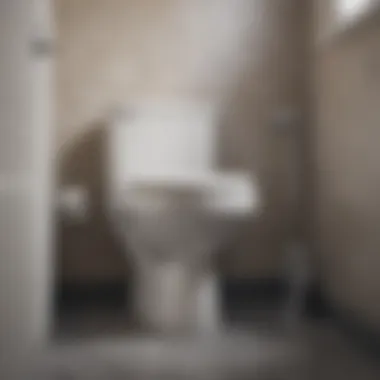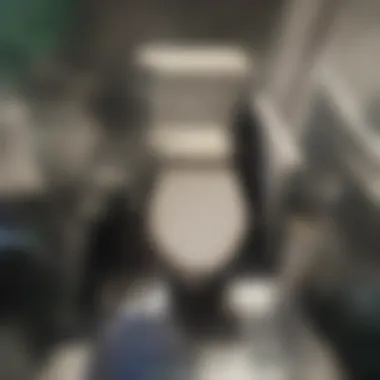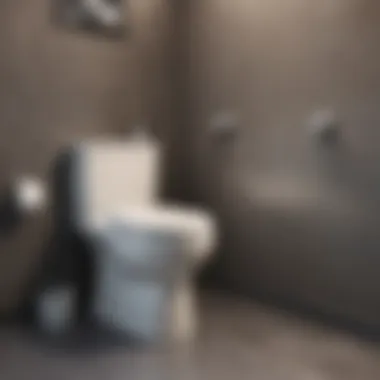Understanding and Resolving Blocked Toilets Effectively


Intro
Blocked toilets are more than just an inconvenience. They often signal deeper plumbing issues that, if neglected, can lead to costly repairs or further complications. Understanding the root causes of a blocked toilet and knowing how to address the issue effectively is crucial for every homeowner. In this exploration, we will examine common causes of toilet blockages, the implications they carry for household plumbing, and practical solutions for remediation.
By providing a thorough understanding of this topic, we aim to equip homeowners with the knowledge to manage toilet blockages competently. The goal is not just to address the symptom but to understand the underlying issues and adopt preventive measures that contribute to overall plumbing health.
Over the following sections, we will delve into:
- Common reasons for blocked toilets
- Immediate solutions to consider
- Tools and materials needed for resolution
- Preventive maintenance tips for plumbing health
This article will serve as a comprehensive resource for individuals interested in maintaining their homes.
Common Causes of a Blocked Toilet
Identifying the cause behind a blocked toilet is the first step toward resolving the issue effectively. Here are several common culprits:
- Excessive Waste: Toilets are designed to handle a certain amount of waste. Flushing more than this can lead to blockages.
- Foreign Objects: Items like toys, feminine hygiene products, or paper towels can get lodged in the plumbing.
- Old Pipes: Deteriorating or corroded pipes can narrow the passageway and increase the likelihood of blockages.
Understanding these factors can help in managing and preventing further issues.
Immediate Solutions to Try
When faced with a blocked toilet, several immediate solutions can be applied:
- Plunger Use: A toilet plunger can often dislodge the blockage effectively. Make sure to use a toilet-specific plunger for best results.
- Hot Water: Pouring hot (not boiling) water into the bowl may help dissolve stubborn clogs.
- Drain Snake: If the blockage persists, a drain snake can reach into the pipes to break up or retrieve foreign objects.
"Regular maintenance reduces the risk of emergency plumbing situations, ensuring a more reliable home environment."
Tools for Effective Resolution
Having the right tools makes addressing a blocked toilet much easier:
- Plunger: Invest in a high-quality toilet plunger with a flange.
- Drain Snake: A manual or powered drain snake can help for deeper clogs.
- Wet/Dry Vacuum: This can remove larger objects or significant amounts of water.
- Gloves: To protect your hands while addressing the blockage.
Preventive Maintenance Tips
To keep your plumbing system running smoothly, implement these preventive measures:
- Regular Inspections: Check for signs of wear in pipes and fixtures.
- Mindful Flushing: Only flush human waste and toilet paper.
- Scheduled Cleanings: Consider periodic professional cleaning of your plumbing system.
Maintaining your plumbing health will mitigate the likelihood of experiencing blocked toilets.
The End
Understanding Blocked Toilets
Blocked toilets symbolize more than mere inconveniences. They compromise sanitation, potentially lead to severe plumbing issues, and disrupt daily life. This segments aims to dissect the critical elements surrounding blocked toilets. First, understanding what constitutes a blockage is crucial for homeowners. It helps in identifying problems early and taking appropriate action.
Defining the Problem
A blocked toilet arises when waste, water, or foreign objects obstruct the normal flow within the plumbing system. This blockage prevents flushes from operating efficiently and can cause unpleasant odors and overflow. It is vital to grasp how plumbing mechanisms function to address blocks effectively. Understanding the problem allows homeowners to assess the severity and determine if a DIY solution or professional intervention is necessary.
Common Symptoms
Recognizing the symptoms of a blocked toilet aids in prompt action. Here are some common indicators:
- Slow Drainage: Water may linger in the bowl after a flush.
- Gurgling Noises: Unusual sounds during flushing typically indicate trouble in the drainage system.
- Unpleasant Odors: A foul smell could signify waste buildup.
- Incomplete Flushes: If water does not fully clear the toilet bowl, this is a classic sign.
Proper identification of these symptoms can guide necessary actions to mitigate further complications.
Each symptom requires a specific approach and understanding these signs can enhance the effectiveness of any intervention.
Common Causes of Toilet Blockages


Understanding the common reasons behind toilet blockages is crucial for effective preventive measures and timely interventions. Blocked toilets can escalate into more serious plumbing issues if left unattended. Identifying these causes helps in developing proper habits and maintenance practices, ultimately saving time and money.
Foreign Objects
Foreign objects in toilets are one of the leading causes of blockages. Items like toys, feminine hygiene products, and even excessive amounts of toilet accessories can create major issues. Not every item is meant to go down the toilet. For instance, toilet paper is designed to dissolve, while objects made of plastic or rubber can sit stagnant in the pipes, causing obstructions.
When a foreign object causes a blockage, it may result in the toilet overflowing or slow drainage. Regular checks can save trouble; if someone hears unusual sounds from the toilet or experiences a slow flush, investigating immediately is wise.
Excessive Toilet Paper Usage
Using too much toilet paper is another common cause of clogged toilets. Toilet paper, while designed to be flushable, can accumulate and create a dense mass inside the plumbing. Individuals may not realize that a single flush might not be enough to clear a significant amount.
When excessive toilet paper usage occurs, it is wise to flush smaller amounts more frequently instead. If the toilet is slow to drain after multiple flushes, it suggests a potential blockage needing attention.
Clogged Pipes
Clogged pipes, sometimes due to accumulated waste, can lead to serious blockages. Over time, debris of various types can build up within pipes, leading to restrictions in flow. This situation often requires professional assessment, as it can affect parts of the plumbing system that are not accessible.
It's worth noting that while some clogs may seem manageable, the bigger picture shows how pipe maintenance plays a role in overall household plumbing health. Ignoring slow drains can lead to severe complications, including pipe bursts or backflow issues.
“Prevention is always more cost-effective than repairs.”
In summary, knowing the common causes of toilet blockages allows homeowners to take proactive measures in maintaining their plumbing. Such information not only improves day-to-day functioning but also fosters a culture of careful plumbing practices.
Implications of a Blocked Toilet
A blocked toilet is more than just an annoyance; it can lead to a myriad of serious issues if not addressed quickly. Understanding the implications of a blocked toilet is critical for homeowners, as it encompasses health risks, potential structural damage, and various inconvenience factors. This section will unfold these implications, emphasizing the benefits of prompt resolution and the consequences of neglecting the issue.
Health Risks
Blocked toilets create a breeding ground for bacteria and pathogens. When waste cannot properly flow through the plumbing system, it can lead to unsanitary conditions. The risk of exposure to infections rises, putting household members at danger. In extreme cases, sewage leaks can occur, further contaminating living spaces. Such situations can result in gastrointestinal issues or skin infections. Homeowners must recognize that ignoring a blockage can compromise the health of their family.
For a thorough understanding of health implications, consider the importance of:
- Proper sanitation practices.
- Regular inspections of plumbing systems.
- Immediate action upon noticing blockages.
Therefore, addressing a blocked toilet is imperative to maintain not only comfort but also health.
Structural Damage
A blocked toilet can have severe implications on a home’s structure. Water backup can lead to leaks and even overflows. If left unchecked, these leaks can damage walls, flooring, and cabinets, potentially leading to costly repairs.
The risks include:
- Mold Growth: Mold thrives in damp conditions. Persistent moisture from leaks can encourage mold, creating health risks and expensive remediation efforts.
- Foundation Issues: Extensive water damage can compromise a home's foundation over time. It's essential to keep plumbing systems functioning properly to avoid structural integrity loss.
Investing time to fix a toilet blockage can save considerable funds on repairs down the line.
Inconvenience Factors
A blocked toilet is not just a plumbing issue; it disrupts daily life. It limits access to essential bathroom facilities, making it a significant inconvenience for all household members. Ensuing stress can impact schedules, particularly in larger families or shared living spaces.
Key inconvenience factors include:
- Bathroom Accessibility: Limited access can force residents to seek alternative arrangements, leading to frustration.
- Cleaning and Maintenance: Continuous blockages require frequent attention, resulting in added chores for homeowners.
- Social Limitations: Having guests can become stressful if restroom facilities are compromised.
In essence, dealing with a blocked toilet expeditiously not only restores functionality but also preserves harmony within the home.
Tools for Resolving Blocked Toilets
Blocked toilets can become a significant issue in any household. Understanding the tools available for resolving these problems is crucial. With the right tools, homeowners can often manage blockages effectively before they escalate into more severe plumbing issues. Here, we explore three essential tools: plungers, drain snakes, and wet/dry vacuums. Each one offers unique benefits and should be considered in the context of specific blockage situations.
Plungers


Plungers are the quintessential tool for addressing a blocked toilet. They are often the first line of defense due to their simplicity and effectiveness. A plunger creates a vacuum-seal when pressed against the toilet bowl, allowing for strong suction to dislodge clogs.
When using a plunger:
- Choose the Right Type: There are different types of plungers available. The flange plunger is ideal for toilets as it fits snugly into the bowl's shape.
- Proper Technique: Ensure a good seal before applying force. Push down and pull up smoothly to create pressure effectively, repeating as necessary.
- Assess the Situation: Not all blockages can be cleared with a plunger. If there are persistent issues, it may indicate a deeper plumbing problem.
Drain Snakes
Drain snakes serve as another valuable tool for tackling tougher blockages. They are long, flexible tools designed to reach deeper into plumbing systems. A drain snake can be an effective solution for stubborn clogs that a plunger cannot resolve.
Using a drain snake involves:
- Inserting the Snake: Carefully feed the snake into the toilet drain until resistance is felt, signifying the presence of a blockage.
- Rotating the Tool: Turn the handle of the drain snake to break apart or grab onto the clog. This method can successfully dislodge hair, grease, or other materials causing the blockage.
- Pulling It Out: After dislodging the clog, slowly pull the snake back to extract debris, ensuring it does not further block the drain.
Wet/Dry Vacuums
For more severe cases of toilet blockages, a wet/dry vacuum can be a lifesaver. These powerful appliances can remove unwanted water and debris without making a mess.
Key considerations for using a wet/dry vacuum include:
- Proper Setup: Ensure the vacuum is set to the wet mode before using it on a toilet blockage. This prepares the machine to handle liquid waste appropriately.
- Sealing the Drain: Create a good seal around the toilet drain with the vacuum hose, ensuring maximum suction effectiveness.
- Safety Precautions: Be cautious when dealing with wastewater. Wear gloves and take appropriate precautions as necessary.
Blocked toilets are not merely inconvenient; they can signal potential plumbing system issues that require timely intervention.
By effectively utilizing these tools, homeowners can address many common toilet blockages, potentially saving both time and money compared to hiring professional services. However, understanding their limitations is equally important to prevent aggravating the situation.
DIY Solutions for Blocked Toilets
Blocked toilets can be a source of frustration. However, many people prefer do-it-yourself solutions before calling a professional. This approach not only saves money but also gives you a sense of control over the situation. Understanding three key DIY methods can help you tackle most blockages effectively.
Using a Plunger Effectively
Using a plunger is often the first step in addressing a blocked toilet. To plunge correctly, ensure you have a flange plunger. This type is designed to seal better within the toilet bowl.
- Positioning the Plunger: Place the plunger in the toilet bowl, ensuring it covers the drain hole completely. This helps create a strong seal to build pressure during plunging.
- Plunging Technique: Use a steady up-and-down motion. Do not directly pull it out of the drain. Instead, plunge down and pull back, keeping the seal intact. Continue this for about 15-20 seconds.
- Testing the Flush: After plunging, test if the blockage has cleared by flushing the toilet. If it still does not drain, you may need to use additional methods.
Employing a Drain Snake
If plunging doesn't work, a drain snake is a useful tool. This device can reach deeper blockages that a plunger cannot. Here are steps to follow when using one:
- Introducing the Snake: Insert the snake into the toilet bowl. Make sure to twist it as you push it through the drain. This helps it navigate the curves in the pipe.
- Removing the Clog: Once you encounter resistance, rotate the handle. This action helps break apart or latch onto the blockage.
- Retrieving the Snake: Once you feel the blockage loosen or break, carefully pull the snake out. Dispose of any debris caught on it. Flush the toilet to check if the flow has improved.
Chemical Drain Cleaners
Chemical drain cleaners can be effective but should be used cautiously. Many of these products contain harsh chemicals that may damage pipes or the environment. Here’s how to use them responsibly:
- Selecting the Right Cleaner: Choose a product suitable for toilets. Read labels to ensure compatibility with plumbing materials.
- Application: Follow the manufacturer’s instructions carefully. Usually, you will need to pour it into the bowl and wait a specified amount of time before flushing.
- Safety precautions: Always wear gloves and goggles. Ensure good ventilation in the bathroom while using these products.
Using these DIY methods can often resolve a blockage without additional costs. It is essential to assess the situation properly and select the most appropriate approach. These methods empower homeowners to address their plumbing issues effectively.
When to Call a Professional Plumber
When dealing with a blocked toilet, it is easy to feel overwhelmed. Not every incident is simply a matter of grabbing a plunger. Recognizing the right time to seek professional help can save you time, money, and frustration. This section outlines key considerations and benefits of involving a professional plumber in such situations.
Identifying Serious Issues
Blocked toilets may seem like a straightforward problem; however, some situations reveal underlying complications. For instance, if multiple toilets in your home are backing up at once, or if you notice gurgling sounds in your drains, it could indicate a more serious plumbing issue. Identifying serious signs is essential:
- Frequent Blockages: If a toilet frequently blocks, it signals a persistent issue. A plumber can assess whether it's a deeper blockage.
- Water Backups: Water backing up into the shower or sink generally indicates a serious clog in the main line.
- Unpleasant Odors: Persistent foul smells are not just uncomfortable; they can hint at sewage problems.
In these cases, a professional can diagnose the problem accurately, preventing potential damage and ensuring safety.
Understanding Plumbing Systems


Understanding how plumbing systems work assists in knowing when the problem is beyond DIY fixes. Plumbing involves a complex array of pipes, valves, and fixtures. Here are critical elements to consider:
- Pipe Configuration: Sometimes, pipelining may lead to under-sink or under-floor blockages that require specialized tools to reach.
- Ventilation Systems: Proper venting is crucial for drainage. If vents are blocked, this can cause drainage issues, which necessitates a plumbing expert.
- Main Sewer Lines: Professional plumbers can check the health of your sewer lines, identifying cracks or breaks that may be exacerbating the toilet blockage.
Involving a professional plumber ensures that the plumbing system is assessed holistically. They have the training and tools to conduct thorough inspections, diagnosing problems that are not visible to the average homeowner.
"Early intervention can save you from extensive plumbing repairs and costly damages in your home."
Remember, while DIY methods can resolve minor issues, knowing the right time to call a plumber is invaluable. Monitor your toilet’s performance and don’t hesitate to reach out when something seems off.
Preventive Measures for Blocked Toilets
Preventing a blocked toilet is essential for maintaining a functioning and healthy bathroom environment. Blocked toilets can lead not only to inconvenience but also to more severe plumbing problems. Taking preventive measures can save time, money, and stress in the long run.
To avoid these issues, it is important to implement strategies that promote proper toilet use and maintenance. By understanding how to use toilets correctly and making regular checks, homeowners can mitigate potential blockages.
Mindful Usage Practices
Mindful usage of toilets involves being conscious of what goes into them. Here are some key practices:
- Avoid Flushing Non-Flushables: Items like paper towels, feminine hygiene products, and wet wipes should never be flushed. These can easily lead to blockages.
- Use Appropriate Amounts of Toilet Paper: Excessive toilet paper can quickly cause clogs. Use only what is necessary for cleanliness.
- Educate Family Members: It is crucial that all members of the household understand proper toilet use. This will help reduce accidental blockages.
These practices encourage better habits that can significantly reduce the likelihood of toilet blockages.
Regular Maintenance Checks
Engaging in regular maintenance checks is vital in preventing blockages before they occur. Here are some recommendations:
- Inspect Toilet Components: Periodically check the flushing mechanism, tank, and pipes for any signs of wear or leaks. Ensuring these parts are functioning properly can prevent larger issues.
- Clear Visible Obstructions: If there are visible signs of blockages in the toilet or near pipes, address them promptly. Remove debris that may obstruct the flow.
- Schedule Professional Inspections: A professional plumber can provide a thorough assessment of the toilet and plumbing system to identify any potential future issues.
Regular maintenance helps detect and prevent problems that could lead to serious plumbing issues down the line.
By adopting these preventive measures, homeowners can preserve their plumbing systems and ensure their toilets function effectively. This proactive approach can minimize unexpected disruptions and maintain a comfortable living environment.
The Role of Plumbing Maintenance
Plumbing maintenance plays a critical role in preventing issues such as blocked toilets. Regular attention to plumbing systems can save homeowners from serious inconveniences and expensive repairs. Understanding the importance of plumbing maintenance involves recognizing the underlying factors that contribute to a smoothly functioning plumbing system.
Importance of Routine Inspections
Routine inspections are essential for identifying potential plumbing problems before they escalate into major issues. During these inspections, common signs of trouble can be detected, such as leaks, corrosion, and unusual noises. Regular checks allow homeowners to monitor their plumbing systems effectively and take action early. This proactive approach helps ensure that blockages and other issues can be addressed before they lead to more serious concerns.
Some key benefits of routine inspections include:
- Early Detection: Catching a problem early can prevent the need for costly repairs.
- Increased Lifespan of Fixtures: Regular maintenance can extend the life of toilets, sinks, and pipes.
- Enhanced Efficiency: Well-maintained systems operate more efficiently, ultimately saving water and reducing utility bills.
Investing in Plumbing Diagnostics
Investing in plumbing diagnostics is increasingly important in today’s technical environment. Advanced diagnostic tools can provide a clear picture of the plumbing health in a home. Techniques like video camera inspections offer real-time assessments of pipe conditions, identifying clog sources or signs of wear that may not be visible otherwise.
Some considerations when looking into diagnostics include:
- Cost-Effectiveness: While there may be an upfront cost for diagnostics, it can lead to savings by preventing larger repairs.
- Informed Decisions: Accurate data from diagnostics allows homeowners to make informed decisions regarding their plumbing needs.
- Technology Adoption: Utilizing the latest diagnostic technology ensures that your plumbing system is assessed with modern techniques.
"The best way to solve plumbing issues is to prevent them from happening in the first place. Routine checks and diagnostics are fundamental in achieving this."
To maximize plumbing performance, homeowners should prioritize maintenance and inspection. Ignoring the plumbing systems can lead to substantial problems, not only impacting the toilet but the whole plumbing infrastructure at large.
Epilogue
Addressing the issues related to blocked toilets is crucial for maintaining a healthy and functional home environment. This article has explored various aspects that contribute to toilet blockages and stressed the significance of proactive measures. Knowing the common causes and the signs of a blockage can prevent minor issues from escalating into major problems, thus saving homeowners both time and money.
Summary of Insights
Throughout the article, we have delved into how clogged toilets are not mere inconveniences but indicators of potentially serious plumbing concerns. We examined the common causes, such as foreign objects, excessive toilet paper, and clogged pipes, alongside the health risks and structural damage that can occur. Additionally, we provided practical tools and methods for DIY solutions, emphasizing the importance of knowing when to involve a professional plumber. Regular plumbing maintenance and mindful usage practices were also discussed as effective preventive measures.
Final Recommendations
In summary, take a proactive approach. Regular inspections can identify issues before they become serious. If a blockage occurs, don't panic—try the appropriate DIY methods first. However, if the problem persists, don't hesitate to seek professional help. Finally, remember that your plumbing system is an essential part of your home that demands care and attention. By adhering to the insights and recommendations provided, you can maintain a functional toilet and contribute to the longevity of your plumbing infrastructure. Investing time in understanding these concepts ultimately enhances the comfort and integrity of your living space.
"An ounce of prevention is worth a pound of cure."
This adage often rings true with plumbing, where routine care can save substantial costs in the long run.







